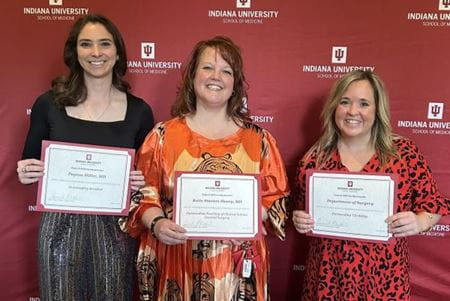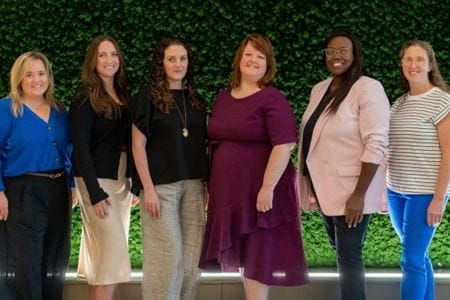For the third consecutive year, the surgery clerkship was voted and awarded the Best Rotation of the Year by the 2025 graduating class at Indiana University School of Medicine, marking the program’s second three-peat in its history. But this achievement didn’t come without challenges. Not long ago, the surgery clerkship held the lowest rating among all rotations, according to graduating student surveys — a reality that University Medical Education Program Manager Megan Rendina, MBA, and her team were determined to change.
“When I first stepped into my role, I basically cleared the slate and started fresh,” Rendina said. “I talked to students, walked through their day-to-day experiences and tried to understand exactly where the friction points were. From there, we built a clerkship grounded in continuous improvement — listening to feedback, making changes in real time and being responsive to what students actually needed.”
The surgery clerkship is an eight-week course intended for third- and fourth-year medical students that incorporates general and subspecialty surgery experiences for over 370 students per year across nine statewide campuses. The all-female clerkship team is made up of staff, teaching faculty, a surgical nurse educator and surgical education research fellows.
“Our success is a direct result of the way we lean into each other’s strengths and work together toward a shared goal: providing the best possible experience for our students,” said Anne Skiles, MSN, RNC-OB, surgical nurse educator. “Our team’s synergy, shared purpose and genuine investment in our students are what made this transformation possible.”
 The journey to transforming the program from one of the lowest rated to the top clerkship in the School of Medicine was no easy feat. Rendina and the clerkship team had to take a hard look inward by evaluating their own practices while also looking outward to identify how they could elevate the student experience and establish the surgery clerkship as a premier rotation.
The journey to transforming the program from one of the lowest rated to the top clerkship in the School of Medicine was no easy feat. Rendina and the clerkship team had to take a hard look inward by evaluating their own practices while also looking outward to identify how they could elevate the student experience and establish the surgery clerkship as a premier rotation.
“We looked outside our own walls by attending educational conferences that aren't necessarily medicine focused, connecting with other institutions and staying curious about what was working elsewhere,” Rendina said. “That outsider perspective has helped us bring in new ideas and try things that might have felt a little unconventional but ended up really resonating with our students.”
In addition to leaning on an outside perspective, student feedback played a critical role in understanding how the clerkship can improve.
“We know the surgery clerkship experience sticks with students, whether they go into surgery or not,” said Cassey Krupa, clerkship coordinator. “We are always looking for ways to improve and create something meaningful and memorable.”
Now a distinguished rotation at IU School of Medicine and a cornerstone of one of the nation’s leading surgical education programs, the Best Rotation of the Year award reflects not only the team's deep passion for surgical skill development but also their unwavering dedication to continually improving the program into what it is today.
“We’re deeply aware of the long-standing stereotypes surrounding surgeons and surgical education,” Skiles said. “Our mission is to challenge and dismantle those perceptions by creating an environment that emphasizes compassion, approachability and genuine investment in student success. We want our students to see that we care — not just about their surgical skills, but about their growth, their well-being and their future, regardless of the specialty they choose.”
